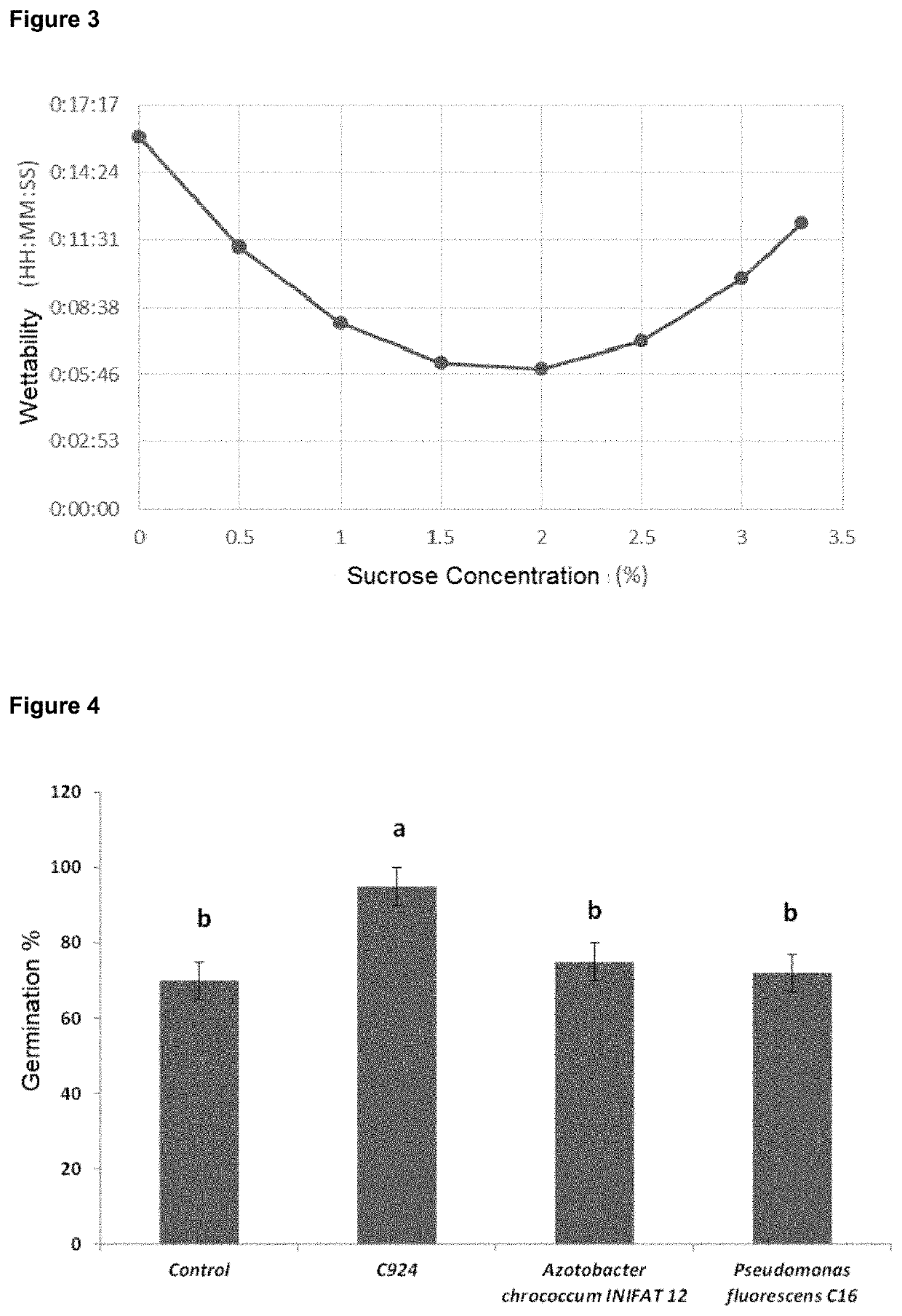Solid composition for agricultural and veterinary use
a technology of solid composition and agricultural biotechnology, applied in the field of agricultural biotechnology, can solve the problems of increasing continuously, affecting the health and environment of several microorganisms that exhibit potent biocontrol activity, and not being easy to use with equal efficiency in field conditions
- Summary
- Abstract
- Description
- Claims
- Application Information
AI Technical Summary
Benefits of technology
Problems solved by technology
Method used
Image
Examples
example 1
n of the Biomass
[0028]The biomass of the bacterial strain C-924, whose deposit number is CBS 613.95, was obtained by submerged fermentation in a batch system, in culture medium with the following composition: Yeast extract, 59 g / L; Sucrose, 170 g / L; Magnesium sulphate heptahydrate, 4.8 g / L and anti-foam Glanapon DG-158 1 g / L. The fermentation was carried out in a fermenter of 50 L of working volume, at 36° C., with an agitation of 500 rpm, an aeration of 1.5 liters of air per liter of culture medium, and a pressure in the glass of the fermenter of 1 bar. The culture was maintained for 72 hours, until the total sucrose added was consumed, and subsequently it was left in stationary phase for at least four hours. The microorganism was harvested by centrifugation in a tubular centrifuge, removing the culture supernatant. The biomass obtained was used in the formulation of the cream, or bacterial concentrate, to be dried. In FIG. 1 the growth kinetics obtained is shown. By the parameters...
example 2
of Additives to Improve the Wettability of the Composition
[0029]An evaluation of the incidence of different additives in the physical properties of the formulation of the bacterial strain C-924, measured through wettability, was made. The biomass was obtained as described in Example 1. The additives evaluated were: acacia gum, xanthan gum, tragacanth gum, SDS, polysorbate 80 (tween 80), polysorbate 20 (tween 20), gelatin, sodium alginate, sucrose, ammonium sulphate, Glanapon DG-158 (Bussetti & Co, GmbH, Austria), Soy lecithin, Carboxymethylcellulose (CMC), Polyethyleneglycol 600 (PEG 600) and Polyethyleneglycol 8000 (PEG 8000). Compositions with a concentration of the microorganism (bacterial strain C-924) between 8.4% and 9.2% (w / w) and culture medium (yeast extract) between 76% and 85% (w / w) were generated. The additives were added in two concentration levels, one minimum (2.3% (w / w)) and the other maximum (10.5% (w / w)), except for xanthan gum. For this compound, the minimum value...
example 3
of Glanapon DG-158 Concentration on the Wettability of the Composition
[0031]To evaluate the influence of the concentration of Glanapon DG-158 on the wettability of the composition, two experiments were carried out, one in the presence and the other in the absence of organic matter, in addition, the concentration of anti-foaming agent Glanapon DG-158 was varied between 0 and 6.6%. The yeast extract was included in the formulation of the first experiment. This was done with a concentration of 23.5% of dry biomass, 67.1% of yeast extract, 1.1% of sucrose, and Glanapon DG-158 was between 0 and 6.6%. The composition of the second experiment did not include yeast extract, and had a concentration of 90.6% of dry biomass, 1.1% of sucrose, and Glanapon DG-158 between 0 and 6.6%. The biomass was obtained as described in Example 1. The drying process was carried out as described in Example 2, using an outlet temperature of 80° C. The response variable measured was wettability, according to the...
PUM
 Login to View More
Login to View More Abstract
Description
Claims
Application Information
 Login to View More
Login to View More - R&D
- Intellectual Property
- Life Sciences
- Materials
- Tech Scout
- Unparalleled Data Quality
- Higher Quality Content
- 60% Fewer Hallucinations
Browse by: Latest US Patents, China's latest patents, Technical Efficacy Thesaurus, Application Domain, Technology Topic, Popular Technical Reports.
© 2025 PatSnap. All rights reserved.Legal|Privacy policy|Modern Slavery Act Transparency Statement|Sitemap|About US| Contact US: help@patsnap.com


